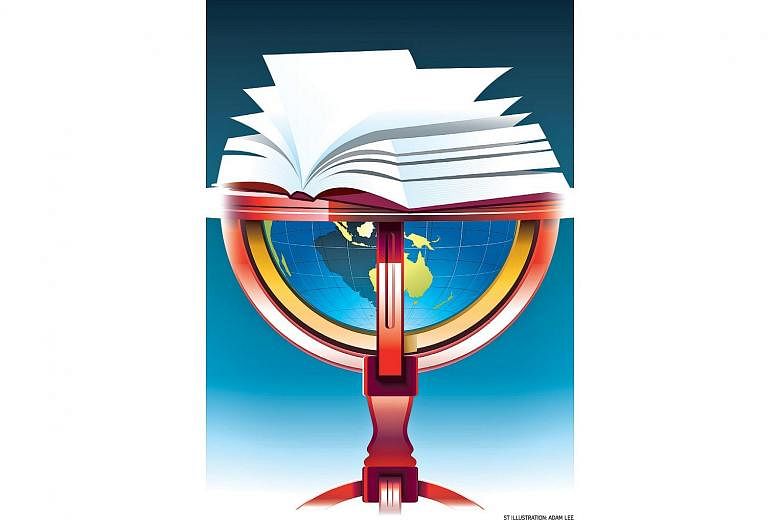When does a piece of writing become "global literature" or "world literature"? The question may seem to be as old as writing itself, but it is in fact historical. And it has as much to do with the manner in which the English language has become globalised as a result of Britain's colonial past as it does with the way in which the literature of other parts of the non-English-speaking world has been relegated to the margins of the exotic and foreign.
In the course of this long historical process, the literature of many societies has been deemed as parochial or "local" by comparison, and this has been to our own detriment as we have overlooked the many important works of literature that have emerged in other non-Western societies.
THE IMPORTANCE OF LIBRARIES
That is why the current exhibition held at the National Library of Singapore is so very important. Entitled Tales Of The Malay World: Manuscripts And Early Books, the library's spectacular exhibition has brought together a large number of beautifully illuminated manuscripts from its own collection as well as the collections of major libraries of Europe. The value of this rare exhibition is that it reminds us that South-east Asia was a major centre of learning and writing, and that the region was home to its own community of intellectuals, philosophers, historians and writers of note.
The works on display at the National Library show that South-east Asian writers busied themselves with the task of writing about many different topics and themes. Though an overwhelming majority of the works that were written in the past were related to religion and scriptural studies, this exhibition also includes some important works that point to the wide range of concerns that drove South-east Asian writers in the past. Ahmad Rijaluddin's Hikayat Perintah Negeri Benggala (An Account of Bengal, written in 1811) for instance, is a rare work that was among the few studies of other non-South-east Asian polities written by an itinerant South-east Asian traveller, making it one of the most important South-east Asian travelogues ever written. The legal compendium Undang-Undang Melaka (codified during the reign of Sultan Muhammad Shah, 1424-1444) on the other hand was an important work on law, written in South-east Asia at a time when the states of South-east Asia had yet to come under colonial rule. Put together, this impressive collection of works - both handwritten and later printed - points to an active writing and reading culture that thrived in our region, long before the coming of Google or Wikipedia.
THE GLOBAL STATURE OF SOUTH-EAST ASIAN WRITING
The question, however, remains: If South-east Asia (like South Asia and East Asia) was a region where writing and intellectual activity was commonplace, why is it that South-east Asian literature remains seen as "unworthy" of global recognition? Until today our region's novelists are sometimes referred to as "Asian writers", while the same might not be said of an American or British novelist. Where lies the bias that continues to frame South-east Asian writing as marginal?
In this respect, two works that are now on display are particularly important to me: The first is the Taj al-Salatin (The Crown of Kings) by Bukhari al-Johori, that was written in 1603. Bukhari's work was, and remains, one of the most important political texts to have emerged in the 17th century, and deals with a range of issues from the authority of government to the duties and responsibilities of rulers. It lays out, in clear terms, the political-social contract between subjects and rulers and constantly reminds the reader of the need for there to be a system of checks and balances, so that political authority would not be compromised.

Again and again, Bukhari reminds the ruler that his authority is based on the support he receives from his subjects, and that support cannot be coerced or taken for granted. In so many ways, this was a modern work of political theory and governance, and a noteworthy observation to be made here is the fact that the Taj al-Salatin was written in 1603, decades before Thomas Hobbes' works De Cive (1642) and Leviathan (1651).
Yet while the works of English political theorists like Hobbes and John Locke have been elevated to the status of "global" political theory, Bukhari's Taj al-Salatin remains confined to the domain of Asian literature and area studies. The same can be said of the political writings of countless other scholars from China to India to Africa, whose works have likewise been categorised and slotted into the marginal categories of "East Asian studies", "South Asian studies" or "African studies".
Another important work on display is a handsome copy of the famous Hikayat Hang Tuah. The tale of the hero Hang Tuah is known to many by now, thanks in part to the manner in which it has been rendered popular in films and even comics. But few may realise that the text is much more complex than it first appears, and this becomes evident when we read it to the very end - and follow Tuah's journey as he evolves to become a diplomat-emissary who travels beyond South-east Asia and ventures to South Asia, East Asia and beyond. It is in the latter half of the Hikayat Hang Tuah that we come to see that the work is not only a heroic epic, but also an account of travel and diplomacy, giving us an idea of how South-east Asians related to the wider world in the precolonial past.
Perhaps the most outstanding aspect of Hang Tuah is how he seeks difference in his travels, and longs to encounter the new; but at the same time reconciles all forms of difference according to the register of the familiar. Throughout his journeys across Greater Asia, Hang Tuah seeks to understand the communities and cultures he encounters with an open mind, guided by the spirit of a shared humanity. Not once does he frame the Other in negative terms, choosing instead to try to understand other societies and cultures as human constructs made by fellow human beings. There is a great universal spirit that permeates this work, and it tells us a lot about how South-east Asians were capable of meeting the wider world without fear.
SOUTH-EAST ASIA AS A GLOBALISED WORLD
Living as we do in the globalised world today, we can see how different societies have coped with the new realities of increased movement and contact. What is sometimes forgotten is the fact that South-east Asia has always been part of a globalised Asia, and South-east Asian writers and thinkers have always regarded themselves as part of a wider global current of ideas and beliefs.
That becomes evident in this exhibition where we see the result of several centuries of cross-border contact and the cross-fertilisation of ideas, as South-east Asian writers wrote about the concerns that were prevalent across the whole of Asia then. The fertile imagination of South-east Asian writers in the past suggests that they were confident of their own beliefs and worldview, and saw themselves as part of a broader global intellectual space that extended from Turkey to China.
Perhaps the most significant takeaway from this wonderful exhibition is that the outdated Orientalist view that South-east Asians were passive witnesses to global history can be debunked once and for all. Bringing together this vast collection of South-east Asian works - primarily from the Malay archipelago - shows how the people of this region produced writings on religion, philosophy, politics, law, history and geography; and were not merely interested in fairy tales or fables.
It is high time that South-east Asians have a sense of their own place in global history as well, and see ourselves as part of a globalised world rather than inhabitants of some remote corner of the globe that time forgot. And it should remind us of the fact that globalisation has never been a new phenomenon to us who live in South-east Asia, for these manuscripts remind us of our global past, and our status as world citizens too.
•The writer is Associate Professor at the S. Rajaratnam School of International Studies, Nanyang Technological University. The exhibition, Tales Of The Malay World: Manuscripts And Early Books, is on now at the National Library of Singapore, until Feb 25 next year.


